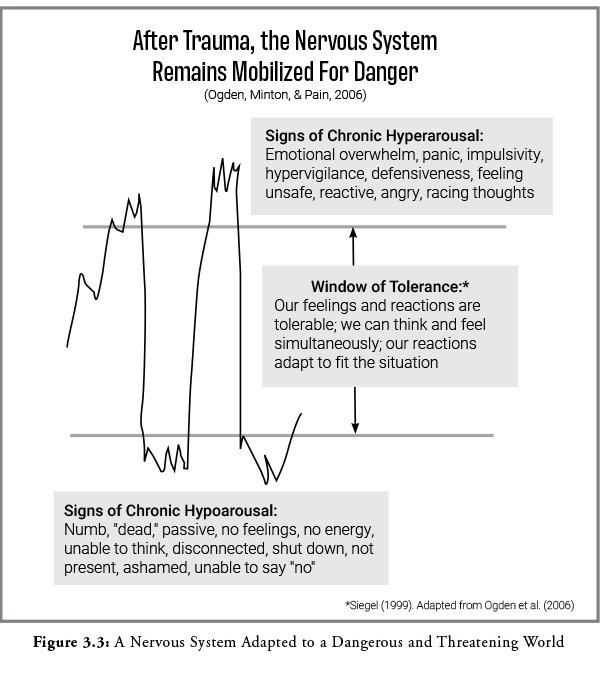The Window of Tolerance
Have you felt completely overwhelmed, with racing thoughts, or impulsive, anxious reactions? Are you constantly jumpy and feeling irritable? Or do you feel numb, exhausted, a “zombie” who has no energy to do anything? Sometimes our nervous systems become chronically stressed and activated. These are signs of hyperarousal or hypoarousal.
We have two branches of the autonomic nervous system– our parasympathetic and sympathetic systems. The sympathetic nervous system works like the gas for our responses (think fight-or-flight) and the parasympathetic system works like the brake. Ideally, we can go back and forth between the two harmoniously. Dan Siegel developed the term window of tolerance, or the optimal “window” of emotional regulation and functionality (1999). The graphic below shows a healthy nervous system operating within the window of tolerance.
Adapted from Ogden et al., 2006; Siegal, 1999; and Segal, 2013.
Sometimes, after traumatic events or chronic stress, we get stuck in states of hypoarousal or hyperarousal or we fluctuate between these two unregulated states. It can look like the graph below.
This image is taken from Janina Fisher’s book Transforming the Living Legacy of Trauma.
Thankfully, we are not doomed to stay in an unregulated state. We can learn to widen our window of tolerance through techniques such as mindfulness, breathwork, stress reduction, self-compassion, grounding exercises, and through safe, interpersonal relationships (such as therapeutic relationships).
Learning to regulate our nervous systems and self-soothe can be a helpful part of therapy. In a regulated state, you are more able to connect with others, learn new coping strategies, and work through memories or events that are triggering you.
If this post speaks to you, please reach out. I can work with you to regulate your emotions and work through traumatic stressors that led to dysregulated states.
Disclaimer: The content provided on this blog is for informational and educational purposes only and is not a substitute for professional mental health advice, diagnosis, or treatment. While I aim to provide helpful and accurate insights, this blog does not establish a therapeutic relationship or constitute personalized advice. Always consult with a licensed therapist or healthcare provider regarding your unique situation before implementing any suggestions shared in this blog.


